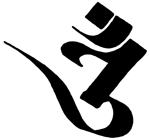
Seed-syllable oṃ
in Siddhaṃ
The first appearance of oṃ in a sacred text is in the Yajur-veda, composed sometime after 1000 BC but before the Buddha, where it was to be uttered loudly by the hotṛ Brahmin at the end of the invocation to the god being sacrficed to (anuvākya) as an invitation to partake of the sacrifice. By the time of the Upaniṣads oṃ had taken on a greater siginificance as a sonic symbol of brahman - the universal absolute. See also notes below
Oṃ seems not to be used by Buddhists until the middle Tantric period - it does not appear in early Mahāyāna dhāraṇī nor in the Mahāvairocana Abhisaṃbodhi Tantra (ca mid 7th century). In the latter mantras begin "namaḥ samanta buddhānaṃ". However it becomes the standard way to begin a mantra at some point after this. Buddhist mantras always seem to use oṃ rather than auṃ. Although Tibetan exegesis gives oṃ a variety of different associations and significations, the main function of oṃ in Buddhist mantras seems to be to mark what follows as a mantra. According to Lama Govinda oṃ presents Buddhahood in potential, and is contrasted with hūṃ which represents Buddhahood made manifest.
Pronounced /õː/ (IPA)
Other bījas: a | āḥ | dhīḥ | hrīḥ | hūṃ | maiṃ | tāṃ | traṃ | phaṭ | svāhā |
oṃ
 |
 |
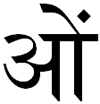 |
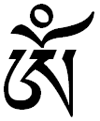 |
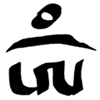 |
| Siddhaṃ | Lantsa | Devanāgarī | Uchen | Ume |
East Asian oṃ
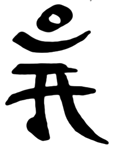
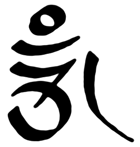 These two characters are attempts to make oṃ look like a Chinese (Seal script) or Korean character.
These two characters are attempts to make oṃ look like a Chinese (Seal script) or Korean character.
The oṃ on the left is based on an image in a British Museum book called Buddhism : Art and Faith, which is no longer in-print but is easily available second hand.
On the right is an oṃ inspired by an image from a Korean temple on Parhessiastes' Flickr site
Notes
Buddhist mantras use oṃ exclusively as far as I am aware, and it should not be confused with auṃ - yes the two are close but they are not identical.
Lama Gonvinda writes about oṃ in Buddhist mantra in Foundations of Tibetan Mysticism although it appears his sources are Upaniṣadic rather than Buddhist - highlighting the derth of information in Tibetan textual sources which continues into the present.
Oṃ was supplanted by 'a' in Buddhism as the most important seed syllable. There is a parallel with early Vedic exegesis (in the Āraṇyaka texts) which treat /a/ as the first phoneme in the syllable and therefore give it precedence, however I think it is unlikely, given Buddhist thinking on the syllable a that Buddhists were drawing on these sources.
Auṃ
The prominence of auṃ ॐ in Hindu traditions is explained by reference to two of the Upaniṣads - which are amongst the later of the "early Upaniṣads". The Maitri Upaniṣad divides oṃ into a + u + m. The three aspects are said to represent, amongst other things, the Hindu trinity or Trimurti in their aspects as creator (Brahmā), sustainer (Viṣṇu), and destroyer (Śiva). The Māṇḍūkya Upaniṣad takes this one step further and makes oṃ itself the fourth aspect which allows it to be related to all manner of four fold lists and symmetries: particularly the four-fold vedas, the four faces of Brahmā, the four Great Elements (earth, water, fire, air), etc. Recall that this theory of associations is an aspect of Vedic thinking millennia before it is incorporated into Tantric systems.
Pronounced /əũ/ (IPA)

| 
| 
| 
| 
|
| Siddhaṃ | Lantsa | Uchen | Devanāgarī modern |
Devanāgarī traditional |
One interesting point here is that the character ॐ is clearly based on a script much closer to Siddhaṃ than it is to Devanāgarī which would write oṃ or auṃ as ओं or औं.
For the early history of oṃ see especially:
- André Padoux. 1990. Vāc : the concept of the word in selected Hindu Tantras.
(Trans. 1992 by Jacques Gontier) Delhi : Sri Satguru Publications.
